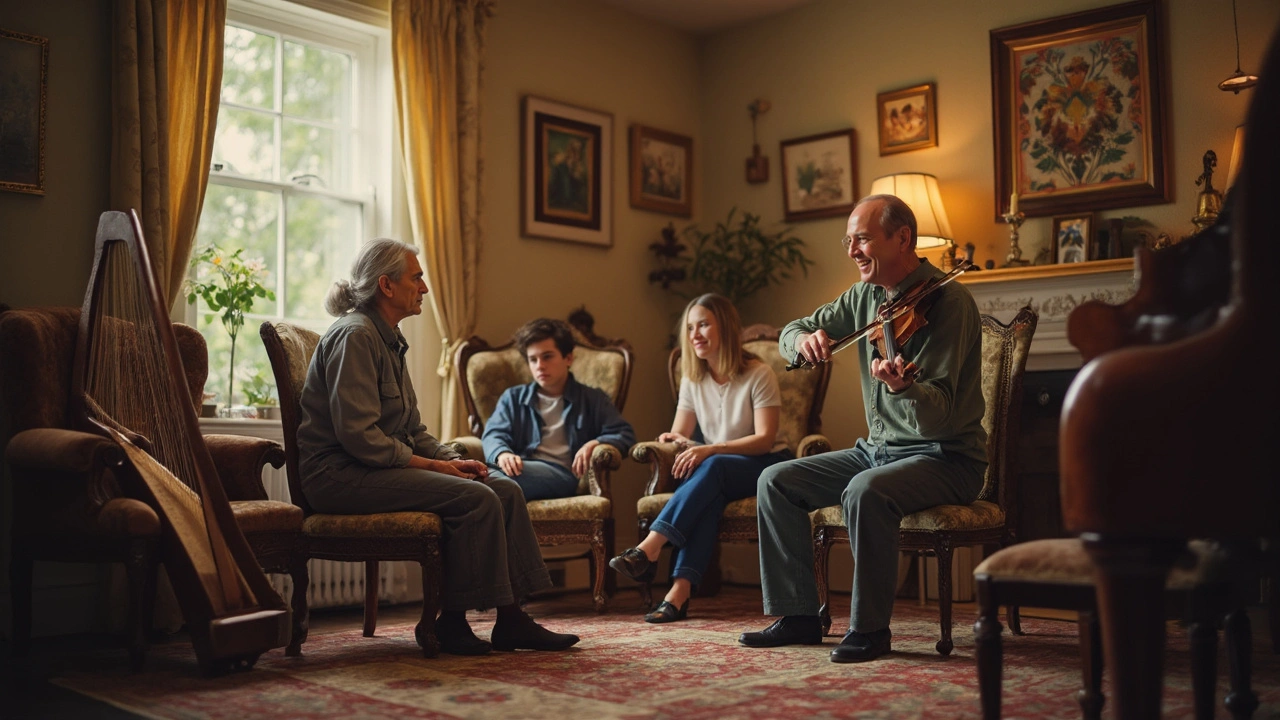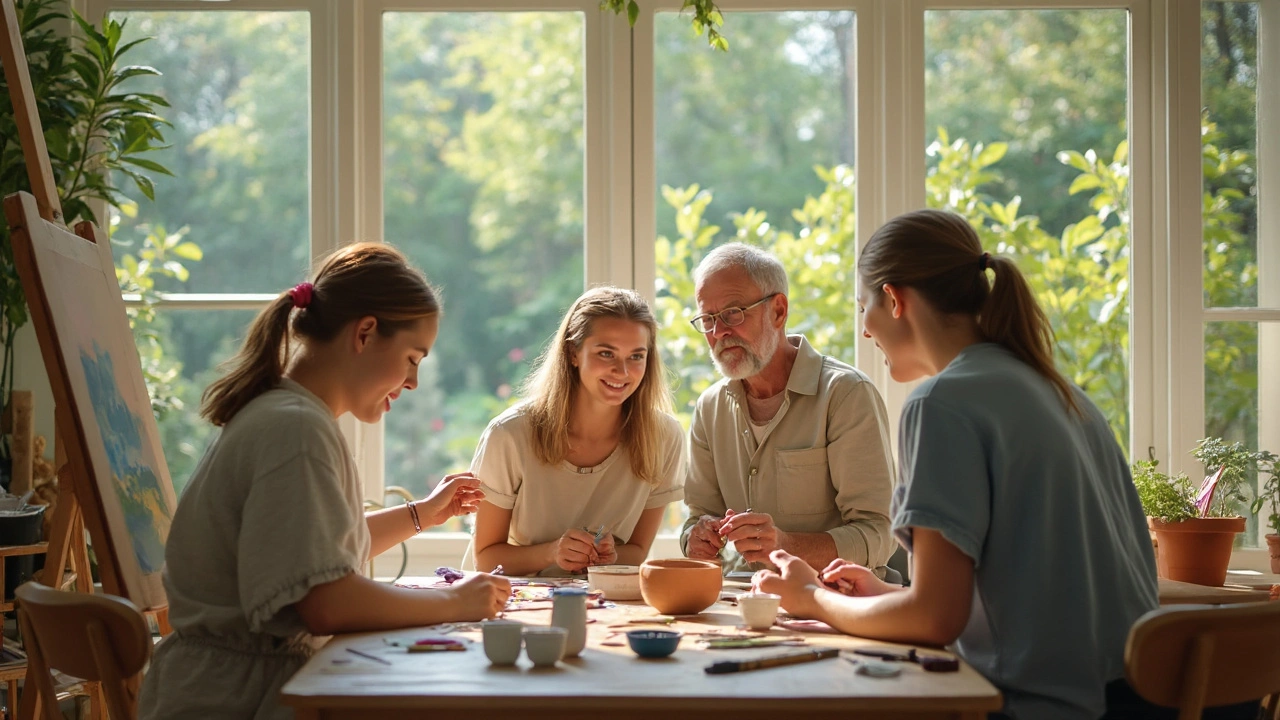Feeling stressed out in today’s fast-paced world? You're not alone. With constant demands on our time and energy, stress seems unavoidable. But here's a fresh perspective: what if engaging in art, music, or even dance could be the solution you need?
Welcome to the world of Creative Arts Therapies. This isn't just your average coloring book activity or a karaoke night. We're talking about using creativity as a powerful tool for mental health. Imagine expressing your feelings through a painting, finding solace in a soothing melody, or releasing built-up tension through dance. Sounds intriguing, right?
Creative Arts Therapies are more than just hobbies—they're structured therapeutic methods designed to heal and relax the mind. These therapies offer a break from the monotony and a chance to reflect and unwind. Whether it's picking up a paintbrush, strumming a guitar, or stepping into a role on stage, these activities can profoundly affect your mental well-being.
- Understanding Creative Arts Therapies
- How Art Heals the Mind
- Music as a Stress Reliever
- The Power of Dance and Movement
- Drama Therapy: Acting Out Your Feelings
- Integrating Creative Arts into Daily Life
Understanding Creative Arts Therapies
What exactly are Creative Arts Therapies? These therapies tap into the creative process to help people express themselves and find relief from stress. Whether it's through painting, playing an instrument, or acting, each therapy offers unique ways to connect with your emotions and thoughts.
The Origins
The idea dates back to mid-20th century when therapists recognized the therapeutic benefits of creativity. Think about it: art has been a way to express thoughts and emotions since the dawn of time! This led to structured ways to use art as therapy, making it available not just for artists but for everyone.
Different Types of Creative Arts Therapies
These therapies aren't a one-size-fits-all solution. They involve various forms like:
- Art Therapy - Uses visual arts to explore feelings and resolve conflicts.
- Music Therapy - Involves listening, singing, or playing music to promote healing.
- Dance/Movement Therapy - Focuses on body movement as a means to express and manage emotions.
- Drama Therapy - Uses theater techniques to help people tell their stories.
Each type has its distinct approach but shares a common goal: stress relief and emotional healing.
How Does It Work?
When you create something, your brain releases dopamine, a feel-good chemical. This can make you feel happier and more relaxed. It’s not just about creating something beautiful—it’s about the process and what you discover about yourself along the way.
Does It Actually Work?
Studies suggest these therapies can reduce stress and anxiety by about 50%. That's no small number. For a lot of people, creative arts therapies offer a new way to face their fears and worries without the pressure of traditional talk therapy.
Ready to give it a shot? It might just be the key to unlocking a stress-free life.
How Art Heals the Mind
Ever wondered why doodling during a long meeting makes you feel more relaxed? Or why smearing paint across a canvas can oddly feel like therapy? It’s because art taps into our minds in ways words can’t.
Engaging More Than Words
The beauty of art is that it's a non-verbal way to show what’s happening inside us. For some, it's easier to draw a feeling than to say it out loud. This kind of expression can be a massive relief, especially when words aren’t enough.
Stress Relief Through Creativity
Creating art releases dopamine, the feel-good chemical. Studies have shown that engaging in any form of creative expression can lower levels of stress and anxiety. It’s like giving your brain a mini vacation.
Boosting Self-Esteem
Completing an art piece boosts confidence. It doesn't have to be gallery-worthy. Just the act of creating something from scratch can make you feel accomplished and proud.
A New Perspective
Art encourages seeing things differently. When you're working on an art project, you might find solutions to problems you weren't even consciously focusing on. This new perspective can bring clarity in other areas of life.
Got a busy mind? Try art journaling. It’s like a diary, but with more colors and fewer rules. Sketch your thoughts, paint over them, or collage your emotions. It’s less about the final product and more about what you discover along the way.
Don’t stress about talent. You don’t need to be Picasso. Even coloring books can bring a sigh of relief. The key is to let your mind wander and your hand follow.
So, next time life gets overwhelming, grab a new canvas or that old sketchbook lying in your drawer. Art might just be the friend you didn’t know you needed.
Music as a Stress Reliever
Strumming away at your favorite tune or getting lost in a soothing melody might just be what the doctor ordered. Believe it or not, music isn't just something we play at parties or hum along to in the shower. It’s a powerful tool that can help tackle stress.
Research has shown that listening to music can reduce anxiety and lower cortisol levels, the body’s primary stress hormone. This makes music an effective stress buster in our daily routine. Ever notice how a fast beat can get you pumped up, while a slow melody can calm you down? That’s music working its magic on your mood!
How Music Works
Music interacts with the brain in fascinating ways. Our brains are wired to respond to rhythms and melodies. When you listen to music, your brain releases dopamine—often called the ‘feel-good’ hormone. This can make you feel happier and more relaxed.
Here’s a handy tip: when you’re feeling overwhelmed, try creating a playlist of your favorite calming songs. Put on your headphones, close your eyes, and see where the music takes you. You might find it comforting and surprisingly therapeutic.
Music as Therapy
Music therapy is a recognized form of creative arts therapy that uses music to address emotional, cognitive, and social needs. Whether it’s playing an instrument or guided music listening, these interventions aim to improve mental health. Studies suggest that regular music sessions can improve mood and decrease feelings of depression and anxiety.
- Start with guided relaxation tracks. These can help to slow your breathing and ease tension.
- Consider joining a music group or choir. Connecting with others through music can boost your sense of community and purpose.
- Don’t shy away from experimenting with different types of music to find what suits you best.
Ready to give it a go? Next time you’re feeling stressed, look no further than your favorite tunes. Just press 'play' and let the music be your stress reliever.
| Benefits of Music | Evidence |
|---|---|
| Reduces anxiety | Study published in the British Journal of Music Therapy |
| Lowers cortisol levels | Research from Stanford University |
| Releases dopamine | Findings from the McGill University, Canada |

The Power of Dance and Movement
Dance and movement therapy might sound like the perfect excuse to just groove around, but its benefits to mental health are pretty serious business. Why? Because movement is more than just exercise—it's an expression. And for those struggling with stress, it’s a fantastic outlet to let those emotions out.
Researchers have found that dance improves mood, boosts self-esteem, and reduces anxiety. When you dance, your brain releases endorphins, those feel-good hormones that help combat stress naturally. Think of it as happiness that you can practice anywhere. Got two left feet? No worries, the effectiveness doesn't depend on skill level. It's all about moving to your rhythm.
How It Works
So, how exactly does shaking a leg help? Dance and movement therapy focuses on the mind-body connection. Practitioners guide participants through movements to encourage self-awareness and emotional release. You’d be surprised how many feelings you can work through by the end of a dance session.
A Quick Dive Into a Session
Curious about what a dance therapy session looks like? They often start with a warm-up, moving into more focused routines that align with mental health goals. Remember, it’s not a dance class, so it’s less about perfecting technique and more about expressing what’s inside.
- Warm-up: Light movements to get your body aware and ready.
- Expressive phase: Use improvisational dance to express inner feelings.
- Cool down & reflection: Slow movements leading into a time to verbalize and process what you feel.
Ready to give it a try? Programs are popping up everywhere, and they’re welcoming to all ages and abilities. Before you know it, you’ll be spinning your stress away!
Drama Therapy: Acting Out Your Feelings
Ever thought about how powerful acting can be? In Drama Therapy, you're not just putting on a show for an audience—you're putting on a show for yourself. It's about stepping into a role that unlocks emotions and perspectives that you might not tap into otherwise. It sounds creative because it is! And it's also surprisingly effective for dealing with stress and mental health issues.
Drama Therapy combines the art of theater with the principles of psychology. It helps you express yourself in a structured yet flexible environment. Imagine a safe space where you can explore big emotions without judgment. Whether you’re working through anger, sadness, or anxiety, acting them out can provide insight and relief.
The Mechanics of Drama Therapy
Drama Therapy can happen in group settings or during one-on-one sessions. Both formats have unique benefits. In a group, you get the added support and perspectives of others, while individual sessions allow for deep personal exploration.
- Role Playing: Take on a character and explore how different situations make you feel. This helps you see problems in a new light.
- Improvisation: Use on-the-spot creation to access thoughts and emotions you might not articulate otherwise.
- Storytelling: Craft and share stories that reflect your personal experiences or fantasies. Writing and performance can offer great relief.
Benefits
At first, the thought of acting out your feelings might feel daunting. But regular practice might surprise you with how much lighter you feel. Here are a few benefits:
- Emotion Expression: Sometimes talking isn't enough. Acting allows a fuller exploration of what you're feeling.
- Social Skills: Working with others in group sessions can enhance empathy and communication skills.
- Stress Relief: Simply put, it's a release of tension and provides a constructive way to vent!
If you're curious, consider finding a qualified Drama Therapist in your area. Or, try it out in a casual setting, like a local theater group, to see how it resonates with you.
Integrating Creative Arts into Daily Life
Ever thought about adding a splash of creativity to your daily routine? Integrating creative arts into your everyday life can be simpler than you think, and it doesn't require you to be a pro artist or musician. It’s all about embracing creativity as a natural part of living.
Start Simple
You don’t have to dive headfirst into creative arts therapy to feel the benefits. Start small. Try doodling while you're on a call or hum a tune while making breakfast. These little acts can slowly become your go-to stress busters.
Weekly Art Sessions
Consider setting aside at least one evening a week for some creative exploration. This could be painting, sketching, or even working with clay. You’d be surprised at how a single hour of creativity can recharge your mental batteries.
Tune into Music
Music can work wonders when you're feeling stressed. Create a playlist that lifts your spirits or helps you relax. Even better, why not learn a simple instrument like a ukulele? Strumming a few chords can be incredibly satisfying and a creative outlet worth exploring.
Dance Like No One's Watching
Physical activity combined with creativity can reduce stress levels significantly. Play your favorite song and just dance around your living room. No choreography needed—just let your body move. This is an empowering practice that connects you to your emotions and relieves tension.
Drama At Home
If drama’s more your style, bring a bit of theatre into your life. Try reading dialogues from your favorite movies or books out loud. It’s a fun way to engage the mind and experience emotions in a controlled, yet lively, context.
Record Your Journey
Keep a journal of your creative activities. Reflecting on what you’ve done can be incredibly rewarding and can highlight the progress in your mental health journey. Plus, it keeps you motivated to infuse more creativity into your life.
By incorporating these simple practices, you'll find that relieving stress and enhancing creativity can seamlessly fit into daily life. It's about making room for creative expression and discovering the joy it brings. Why not give it a try and see the difference?
| Activity | Time Required | Potential Benefits |
|---|---|---|
| Painting or Sketching | 1 hour per week | Improves focus, boosts mood |
| Listening to Music | Daily | Reduces anxiety, lifts spirits |
| Dancing | 10-15 mins | Relieves tension, increases energy |






